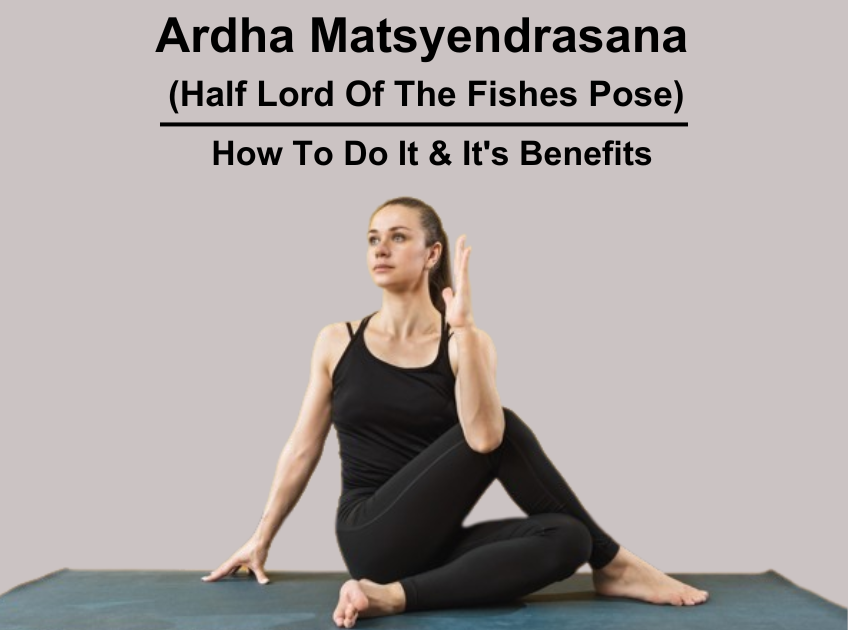
Ardha Matsyendrasana, commonly known as the Half Lord of the Fishes Pose or Seated spinal twist, is a revered yogic posture that goes beyond physical flexibility. This twisting posture is named after the yogic sage Matsyendra, embodies the essence of balance and twist, promoting harmony within the practitioner.
In this article, we will learn deep into the intricacies of Ardha Matsyendrasana, therapeutic applications, historical roots, and anatomical engagement, You'll also learn how it builds a foundation for advanced yoga postures, and discover its key benefits
Ardha matsyendrasana meaning: Here Ardha is half, matsya is fish and eendra means king. This asana is called half because it is half pose of the another yoga asana named by sage matsyendranath poornmatsyendrasana.
Ardha matsyendrasana pronunciation: Ardh + matsya + endra + asana
Always consult with a healthcare professional before attempting any new yoga posture, especially if you have pre-existing medical conditions.
Ensure a thorough warm-up of the spine, hips, and shoulders to prepare the body for the twist.
Practice on an empty stomach or at least 3-4 hours after a meal.
Be mindful of any existing injuries, particularly in the spine, knees, or hips.
Enter the pose gradually, being mindful of your body's capacity.
_1707288578.png)
Step1. Begin in a seated position with your legs extended.
Step2. Bend the Right Knee. Bring the right foot close to the left hip, placing it on the outside of the left knee.
Step3. Twist the Torso. Inhale while elongating the spine, and exhale while twisting to the right, placing the left elbow outside the right knee.
Step4. Finally, hold the right foot with the left hand while the right hand is placed behind, maintaining a straight spine.
Hold the pose for 20-30 seconds and repeat the same sequence on the opposite side.
1. Spinal Flexibility- Enhances the flexibility of the entire spine.
2. Digestive Health- Stimulates the abdominal organs, aiding digestion.
3. Detoxification- Facilitates the release of toxins through the twisting motion.
4. Stress Reduction- Alleviates tension in the spine and promotes a sense of calm.
5. Obesity- As the body is twisted, the metabolism of the body increases resulting in fat reduction.
6. Stimulation of Organs- Massages and stimulates the liver, kidneys, and pancreas.
7. Sciatica Relief- Helps alleviate pain associated with sciatica.
8. Menstrual Discomfort- Eases menstrual discomfort through gentle compression of abdominal organs.
9. Diabetes- The action of this pose, directly involving the pancreas and surrounding organs, may assist in releasing glucose digesting enzymes, which can help in lowering glucose levels in the bloodstream
10. Bronchitis- Continuous breathing empowers the lungs and reduces bronchitis issues.
11. Improved Posture- Strengthens the back muscles, contributing to improved posture.
Also Read: Benefits Of Gomukhasana Yoga (Cow Face Pose) & How To Do It? - A Step-by-Step Guide
Spinal Injuries: Individuals with spinal injuries or recent surgeries.
Pregnancy: Pregnant women, particularly during the second and third trimesters.
Hypertension: Individuals with high blood pressure.
Recent Abdominal Surgeries: Those who have undergone recent abdominal surgeries.
Matsyendra was a sage who was believed to be one of the first teachers of Hatha Yoga. The beginnings of this pose are found in ancient yogic texts, where a sage is referenced.
Spinal Rotation: Engages and stretches the muscles along the entire length of the spine.
Hip Flexors: activate and stretch the muscles around the hips.
Abdominal Muscles: Involve a gentle compression, stimulating the abdominal organs.
Shoulders and Chest: Opens the chest and shoulders, enhancing flexibility.
Paripurna Matsyendrasana - Full Lord of the Fishes Pose.
Marichyasana III- Sage Marichi III.
Also Read: Benefits Of Bhadrasana Yoga (Butterfly Pose) & How To Do It? - A Step-by-Step Guide
In conclusion, Ardha Matsyendrasana (Half Lord of the Fishes Pose) stands as a potent yet accessible practice for enhancing spinal flexibility and fostering a greater sense of overall well-being. Think of it as a gentle unwinding, a way to release tension and cultivate suppleness throughout your back and hips.
Begin by mindfully placing your left foot, engaging in a gentle externally rotating of the thigh to establish a stable and grounded foundation. As you settle, remember the importance of your breath; breathe deeply, allowing each inhale to lengthen your spine, creating space for the gentle rotation that follows. Whether you choose to clasp your hands behind you, opening the shoulders, or find a comfortable bind, the intention is to encourage a deeper twist pose, respecting your body's current capacity.
Gently guide the rotation by using the connection between your opposite hand and your knee and reach, allowing the twist to unfold organically. Throughout this action, maintain awareness of your top leg, keeping it active and grounded on your yoga mat for support. Finally, extend your left arm softly behind you, letting your gaze follow, deepening the stretch along your spine and into your shoulders.
Consistent and mindful practice of this fundamental seated twist on your yoga mat is the key to unlocking its numerous benefits, leading to increased spinal mobility, improved balance, and a greater sense of ease within your body.
If you are a beginner in yoga and want to practice yoga on a regular basis but don’t know how to start properly or the correct way to perform yoga asana, the Yoga for Beginners course is the perfect option for you.
You can join the 100 hour yoga teacher training course from one of the best yoga teacher training in Rishikesh. If you are interested in healing and meditation, you can check out the amazing sound healing course in Rishikesh.